story by Kayte Deioma
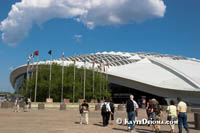 The Biodôme is a unique concept that combines properties of a natural history museum, zoo and aquarium. Created inside the velodrome from the 1976 Summer Olympics, this “House of Life” recreates four different ecosystems of the Americas, each with appropriate climate and inhabited by thriving flora and fauna.
The Biodôme is a unique concept that combines properties of a natural history museum, zoo and aquarium. Created inside the velodrome from the 1976 Summer Olympics, this “House of Life” recreates four different ecosystems of the Americas, each with appropriate climate and inhabited by thriving flora and fauna.
The stated mission of the Biodôme is to educate people from an early age about the importance of protecting the world’s diverse environments. It is also an active research institute with various plant and animal species being studied and some endangered species being bred for release into the wild.
The Tropical Forest
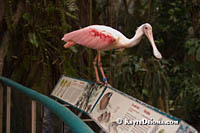 Because the world’s rainforests, although covering only 7 percent of the earth’s surface, contain over half of all known plant and animal species, theTropical Forest is the largest ecosystem in the Biodôme. It is based on a Costa Rican rain forest with an average temperature of 82 degrees with 70% humidity. There are over 1000 plants of 400 species including strangler figs and other trees that have to be trimmed to keep them from breaking through the glass roof. The 8500 square feet (2600 sq meters) in the Tropical Forest is planted in three different growth phases from new growth, which
Because the world’s rainforests, although covering only 7 percent of the earth’s surface, contain over half of all known plant and animal species, theTropical Forest is the largest ecosystem in the Biodôme. It is based on a Costa Rican rain forest with an average temperature of 82 degrees with 70% humidity. There are over 1000 plants of 400 species including strangler figs and other trees that have to be trimmed to keep them from breaking through the glass roof. The 8500 square feet (2600 sq meters) in the Tropical Forest is planted in three different growth phases from new growth, which 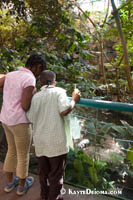 easily allows the light to filter through to old growth, where the tops of the trees block the sun.
easily allows the light to filter through to old growth, where the tops of the trees block the sun.
Among these plants live over 3000 members of 120 animal species from tiny poison arrow frogs to two-toed sloths and friendly roseate spoonbills. A waterfall creates a stream that runs through the forest with alligators and turtles looking for a spot of sun on the sand bank. The gold lion tamarin, a little orange monkey from Africa, is one of the endangered species that has been successfully bred here, with a new addition to the family born May 1, 2006. The path is high above the alligators and piranha but the curious monkeys and birds are free to follow you around if they so choose.
The Laurentian Forest
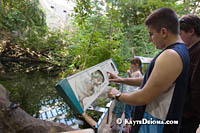 The Laurentian Forest is a native of Quebec’s Laurentian Mountains, so it’s not transplanted far from home. With a combination of deciduous and conifer trees, this ecosystem changes most with the somewhat altered artificial seasons. In this idealized climate, spring comes early and winter is a balmy 54 degrees (12 C) during the day and 39 (4-5 C) degrees for 8 to 12 weeks of nights. The sugar maples and yellow birches here change color in fall and lose their leaves in winter, but it only snows in the Polar exhibit.
The Laurentian Forest is a native of Quebec’s Laurentian Mountains, so it’s not transplanted far from home. With a combination of deciduous and conifer trees, this ecosystem changes most with the somewhat altered artificial seasons. In this idealized climate, spring comes early and winter is a balmy 54 degrees (12 C) during the day and 39 (4-5 C) degrees for 8 to 12 weeks of nights. The sugar maples and yellow birches here change color in fall and lose their leaves in winter, but it only snows in the Polar exhibit.
Many of the animals in the Laurentian Forest prefer to come out at night, but you can find porcupines, river otters and beavers hanging around the beaver dam. If you’re lucky, you might catch a glimpse of a Canadian lynx skulking through the forest.
The St. Lawrence Marine Ecosystem
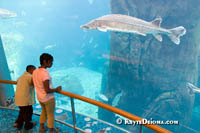 The St. Lawrence River is the southern waterway defining the island of Montreal, so this ecosystem is right in its own neighborhood. The exhibit recreates the underwater environment in a 2.5 million liter (650,000 gallon) saltwater tank filled with hundreds of fish from salmon to sharks.
The St. Lawrence River is the southern waterway defining the island of Montreal, so this ecosystem is right in its own neighborhood. The exhibit recreates the underwater environment in a 2.5 million liter (650,000 gallon) saltwater tank filled with hundreds of fish from salmon to sharks.
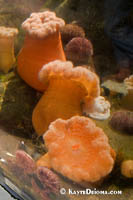 The Rocky Shore area is filled with a garden of invertebrates. Rock crabs crawl among the colorful green sea urchins, bright orange northern sea anemones and fuzzy sea peaches. You get a unique view of the underside of star fish and other creatures who have taken up residence on the glass wall.
The Rocky Shore area is filled with a garden of invertebrates. Rock crabs crawl among the colorful green sea urchins, bright orange northern sea anemones and fuzzy sea peaches. You get a unique view of the underside of star fish and other creatures who have taken up residence on the glass wall.
The stark Rocky Cliffs area with its painted wintry sky backdrop is populated by seabirds like black-legged kittiwakes and black-crowned night herons who nest on very realistic artificial rock outcroppings. In the spring you can check out the parenting skills of mama and papa birds as they teach the young ones the way around the mock-river.
The Polar World
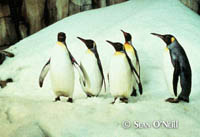 The final and smallest ecosystem of the four is the Polar World, which is divided into subarctic and subantarctic zones. There are no plants here. The subarctic habitat represents the Labrador coast with its rocky shore. It is populated by puffins, guillemots and other auks. The auks look like they should be related to penguins, but they are a different species, which, unlike their southern counterparts, can actually fly.
The final and smallest ecosystem of the four is the Polar World, which is divided into subarctic and subantarctic zones. There are no plants here. The subarctic habitat represents the Labrador coast with its rocky shore. It is populated by puffins, guillemots and other auks. The auks look like they should be related to penguins, but they are a different species, which, unlike their southern counterparts, can actually fly.
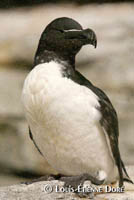 The subantarctic zone is home to 40 different kinds of penguins. There is a glass corridor which separates you from these two chilly climates and separates them from each other. The auks’ habitat is kept a mild 54 to 59 degrees (12-15 C), while their less-flighty neighbors prefer it just above freezing so they can play in the man-made snow. About 20 auks and penguins are born here every year. You’ll find the auks raising their chicks in August and the penguins hatching in November and December.
The subantarctic zone is home to 40 different kinds of penguins. There is a glass corridor which separates you from these two chilly climates and separates them from each other. The auks’ habitat is kept a mild 54 to 59 degrees (12-15 C), while their less-flighty neighbors prefer it just above freezing so they can play in the man-made snow. About 20 auks and penguins are born here every year. You’ll find the auks raising their chicks in August and the penguins hatching in November and December.
Downstairs, the Naturalia Room provides hands on activities and games for learning about how the features and senses of the animals in the upstairs exhibits are adapted to their environments. There is also a permanent exhibit, the Fossil Affair, with 4 billion years of history in rocks.
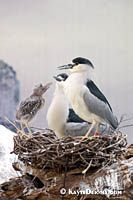 Hour-long audio guides are available in English, French and Spanish. The Biodôme has a gift shop with a great selection of educational toys, games, artifacts and activities in French and English. There is also a snack bar and a cafeteria.
Hour-long audio guides are available in English, French and Spanish. The Biodôme has a gift shop with a great selection of educational toys, games, artifacts and activities in French and English. There is also a snack bar and a cafeteria.
Biodôme
4777 Pierre-De Coubertin Avenue
Montréal, Québec
H1V 1B3
Telephone: (514) 868-3000
Website : www.biodome.qc.ca
Metro : Viau Station on the Green Line
In the high season from May to October, a free shuttle links the Biodôme with the parking lot, Viau Metro station, Olympic Park, Insectarium and Botanical Gardens.
